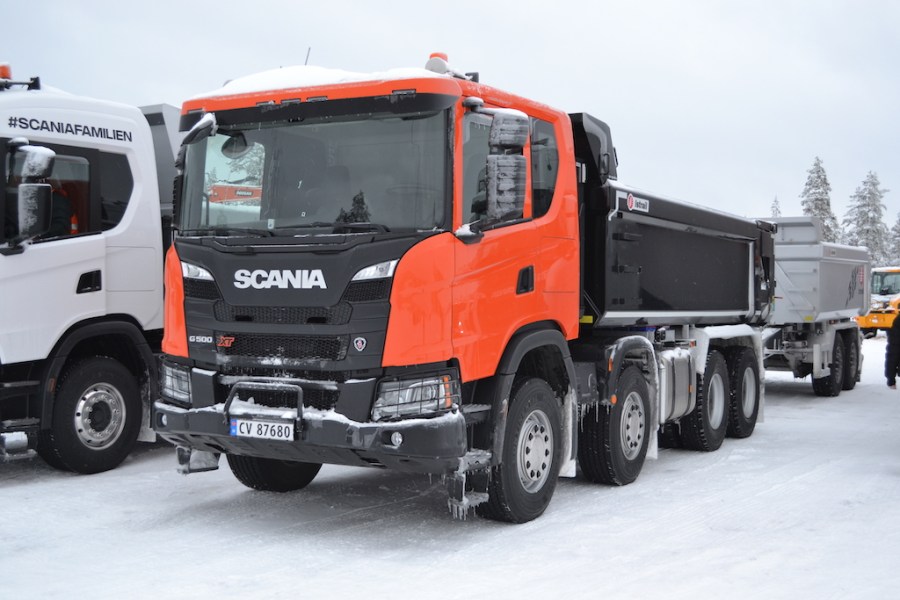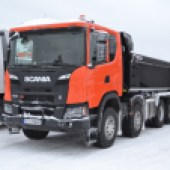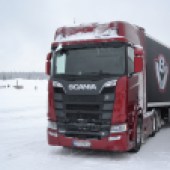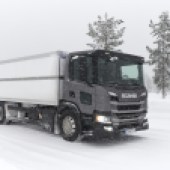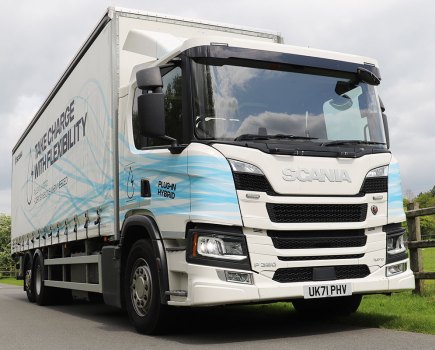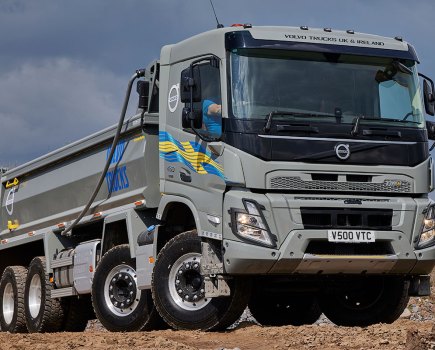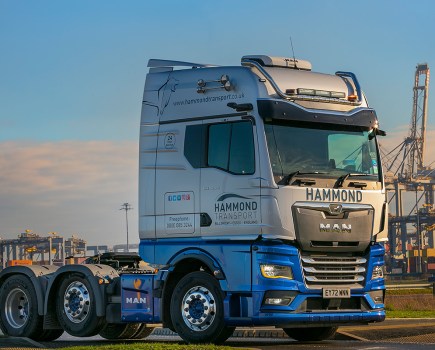We put three of Scania’s Next Gen trucks through their paces in the frozen wilds of Norway to see how they perform in ‘proper’ tough wintry conditions.
While some parts of Britain are battling against wintry weather in early 2018, spare a thought for Norway’s truckers. With temperatures south of -10 degrees C and many metres of snow falling over the cold season, the nation’s commercial vehicles and their drivers have an arduous task.
To get some idea of what it’s like to operate in such a tough environment, Scania recently took us to the bleakly beautiful Norwegian town of Trysil to take a range of its most recent truck models out for a good old ‘play’ in the snow. The trucks were kitted out with snow tyres and were carrying snow chains as is required by Norwegian law this time of year, but other than that they were pretty standard spec – and we were certainly interested to see how they would perform.
Two days before our test, the weather was -1 or -2 degrees C and raining, which meant the roads were particularly icy. As we crunched our way across the yard to the test trucks, the day had settled at -4 degrees C and heavy snow overnight meant the slippery roads were now also covered in a blanket of the white stuff. Before we set out, we were warned that traction could well prove a problem because even though the ambient temperature was cold, it wasn’t cold enough to keep the snow frozen hard, which would have made for easier running.
G500 8×4
The first truck we tried out was a 8×4 G-series XT tipper with drawbar trailer. It was spec’d with a Low Sleeper cab and 13-litre, 500 bhp V8 which produces a max torque of 2550 Nm at 1000-1300 rpm.
The new G-series was launched in June last year and includes five basic configurations: G-sleeper Low, G-sleeper Normal, G-sleeper Highline, G-short and G-day cabs. Since the cabs are now sitting slightly lower, Scania has been able to increased internal measurements to allow for some additional headroom. Normal cab height has been increased by 10 cm, while Highline versions are boosted by 16 cm over previous models.
Each cab variant can be specified with powertrains ranging from 280-360 bhp 9-litre, five-cylinder engines to 13-litre, six-cylinder lumps rated from 370-500 bhp.
Also on offer on G-series is Scania’s newly improved Opticruise automated transmission with layshaft brake, which gives quicker, smoother gear changes. It also reduces the time required to engage reverse and crawler gears, and PTOs if fitted.
Like R-, S- and P-series, G-series’ driving seat has been moved to increase visibility. The driving position has be shifted slightly forwards, which combined with a lower dashboard, windowsills and revised A-pillars means we could get a good view of our stunning winter surroundings.
Our test truck was hitched to a two-axle drawbar trailer and we were grossing 50 tonnes with a load of rocks and gravel. It’s a typical truck for tough driving conditions, so it should behave well on this trip.
Easing out of the demo yard onto the main two-lane highway that leads down a long hill to a bridge spanning the frozen river at Trysil, we kept the retarder off and relied on service brakes to keep our speed to a steady 50 kmh. We were advised to keep the diff lock set to stage one all the time in these conditions to help ensure grip on the ice, but we didn’t notice any adverse affects on the truck’s steering.
With no drama on our descent, we took the right filter off the highway to cross the bridge to a roundabout on the far bank. Here, we did a 180 and headed back across the river, where we then made a left-turn at the base of the hill to start the long climb back up.
From a standing start on ice, the G500 pulled away well (though we did feel a bit of wheelspin) and the smooth 12-speed Opticruise brought us back up to speed. We could feel the heavier weight on our climb – with our foot flat on the floor, the G500 settled in at about 35 kmh in ninth gear in Standard mode.
About two thirds of the way up the slope, we took a sharp right and headed into the trees for a spot of scenic rural sightseeing. The going was much tougher here; snow was piled high and it was difficult to tell where the twisting road was leading. To help us solider on, we flicked Opticruise to Power mode to enable gears to be held longer and at higher rpm. The snow was soft so we had to be careful to not sink our tyres into the verge as we twisted and turned through the trees, before joining an even narrower track that would lead us back to the main highway.
After a good start, things went south as we slowed a bit too much before a tight left-turn on an incline. As we started to climb, we felt the traction go as our wheels spun on the ice. Ordinarily we would have rolled back a bit to make a second attempt, but as our drawbar trailer was still on the slant in the turn there was no option but to climb out and shovel some gravel under the drive axle.
Thankfully, after we’d kicked some grit it into place, we climbed back in, gently ease off in first gear and were on our way back to base.
S650 6×2
For our second drive, we chose an S650 tractor unit. With only one drive axle, we thought this truck would struggle to cope with the ice and snow – but it actually acquitted itself well.
Taking the same route as before, but avoiding the scenic route altogether (the demo drivers had tried it earlier and had also become stuck), we settled in for a pleasant and comfortable drive. Again, service brakes were used to control our descent, and once across the bridge we were ready to make the standing start back up the hill.
When we spotted a gap in the traffic, we gently leant on the gas but felt the wheels spinning once more. To help us out, we dabbed at the Load Transfer controls on the dash to put more weight on the drive axle. Once set to 13 tonnes, we felt the tyres bite and away we went.
P220 B4x2LB
Once back at the yard, we spotted a new arrival just pulling in – a P220 B4x2LB with FOKOR body aimed at urban distribution. The truck was fitted with Scania’s recently released 7-litre, 220 bhp engine which hadn’t yet had a press outing, so we were of course keen to give it a go.
We’ve noted before how much visibility the P-cab offers, and our Low cab was also fitted with Scania’s new City Safe Window in the passenger-side doorframe.
Starting it up, we immediately noticed how quiet the new 7-litre powerplant is. Often, drivers of smaller trucks suffer a noisy cab, but the soundproofing in the P-cab matched with efficient engine tuning dampened the note to a comfortable background rumble – no matter how hard we worked the motor.
The test truck was running with an eight-speed automated transmission, which we opted to use in manual mode around the short test track at the Scania demo centre. The course is used as a racetrack in the summer months, so it provided plenty of bends, hills and descents for us to negotiate. We stuck in fourth gear for most of it, and the truck performed admirably.
More information: https://www.scania.com/uk

